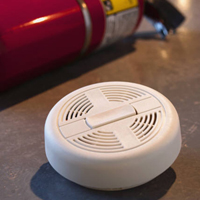Posts Tagged ‘“smoke alarm safety”’
Daylight Saving Time is Time to Check Smoke Alarm Batteries
 Each day, it gets darker outside earlier and we are reminded that Daylight Saving Time is almost here. Next Sunday, Nov. 7, we “fall back” again and set our clocks back an hour.
Each day, it gets darker outside earlier and we are reminded that Daylight Saving Time is almost here. Next Sunday, Nov. 7, we “fall back” again and set our clocks back an hour.
Daylight Saving Time began during World War I to take advantage of the longer days and save energy costs from increased sunlight. Retailers like it because they believe it increases evening shopping. But today, fire departments across the country use it as a reminder to check the batteries in your home’s smoke alarms.
It’s important to follow this advice. Approximately every three hours a home fire death occurs in the United States. Eighty percent of these occur in homes without working smoke alarms. Many other people sustain serious personal injuries.
Daylight Saving Time is also a good opportunity to test your smoke alarm, although the Consumer Product Safety Commission (CPSC) recommends smoke alarms be tested once a month.
In between monthly checks, pay attention for failing batteries. It’s time for a new battery if a smoke alarm begins to chirp. This is the smoke alarm’s low-battery warning.
Also make sure you have an adequate number of smoke alarms to protect your home. The CPSC recommends at least one smoke alarm on each level of your home. Make it a priority to place alarms near bedrooms and inside bedrooms. If you are changing the wiring in your house, wire your smoke detectors together. That way, if one goes, they all go.
Another suggestion is to produce a fire evacuation plan and do a home fire drill. When there is a plan, people panic less and there is a better chance they will escape the flames faster. For assistance with this, visit the National Fire Protection Association’s web page on fire escape planning.
For more information on smoke alarm safety, visit the Consumer Product Safety Commission’s website.
Read More

